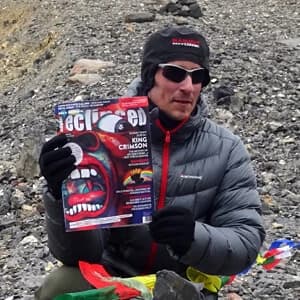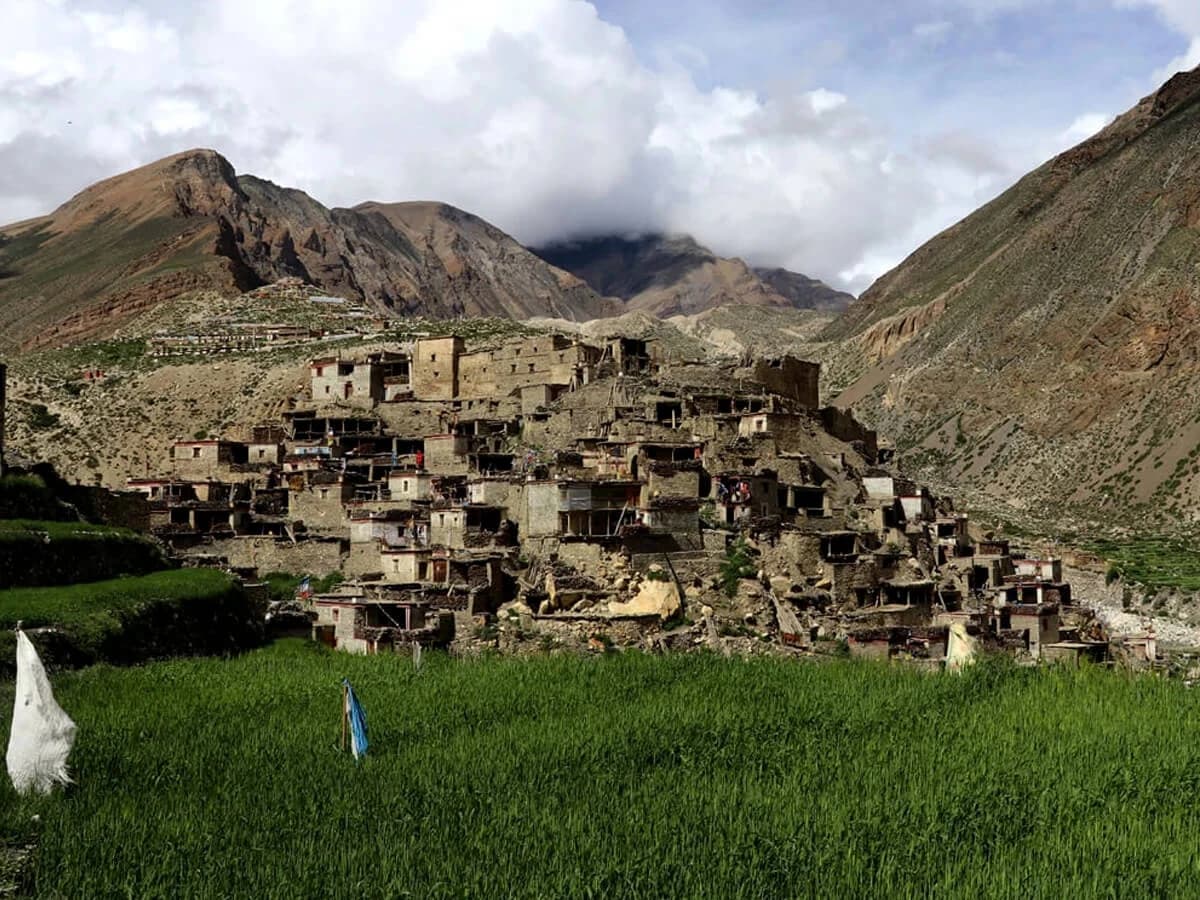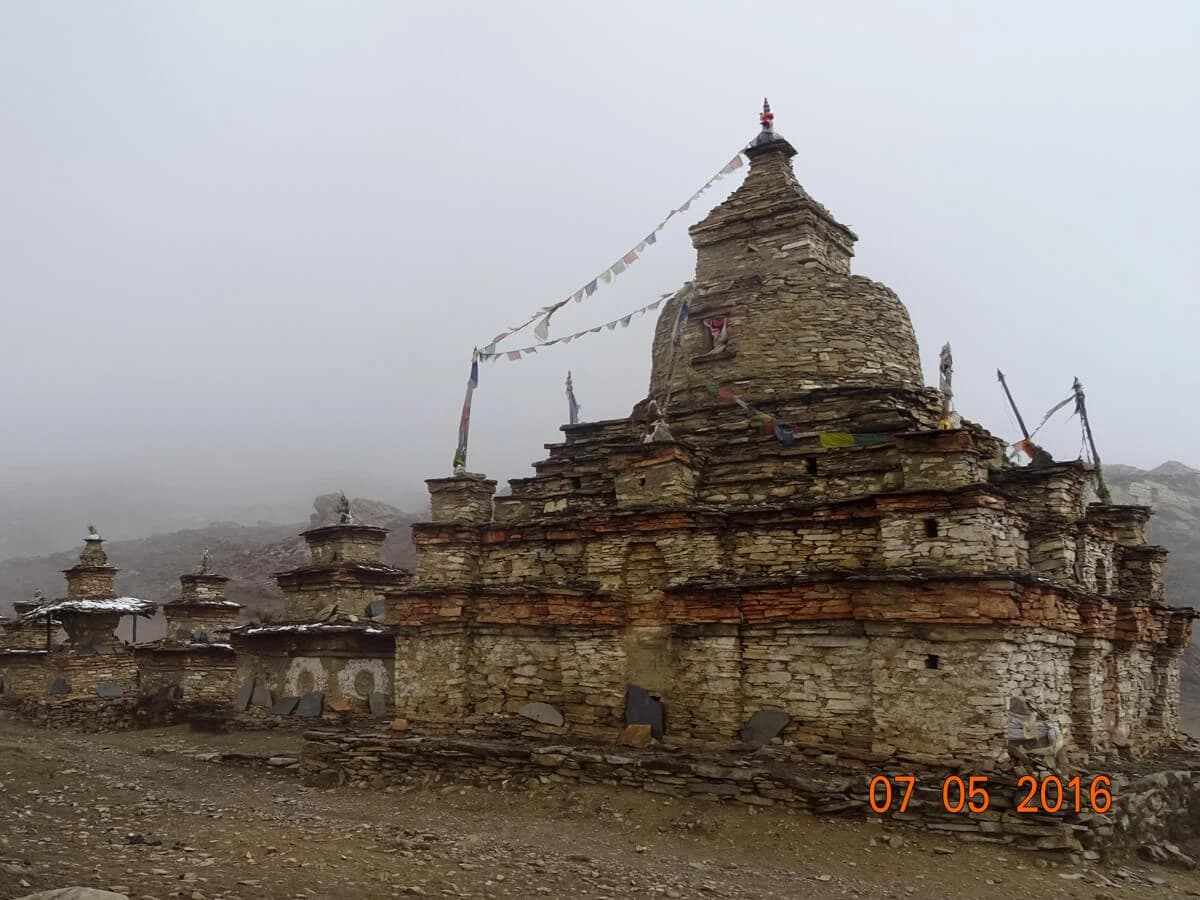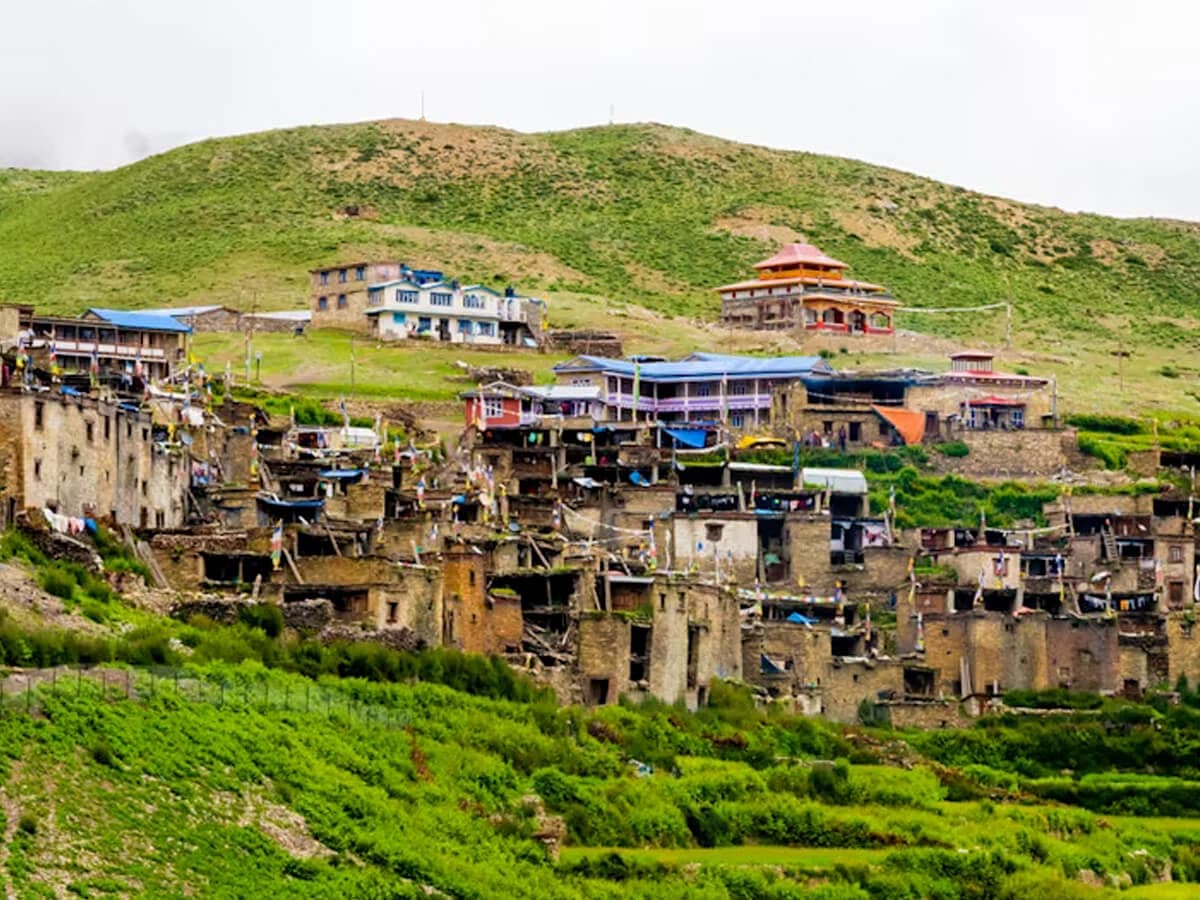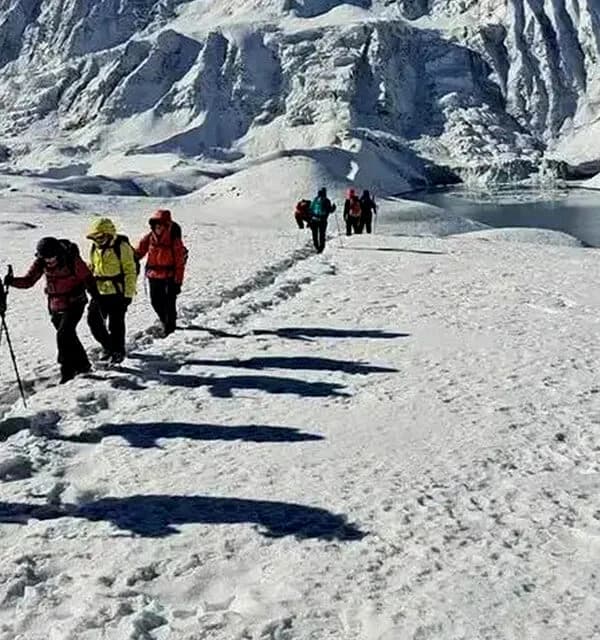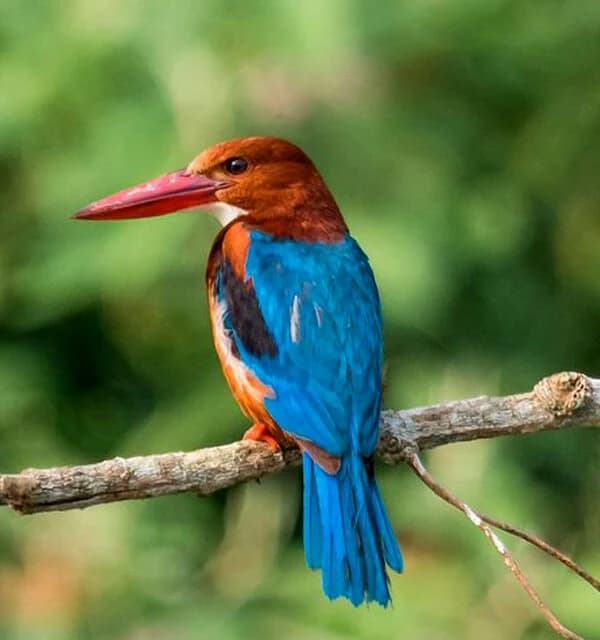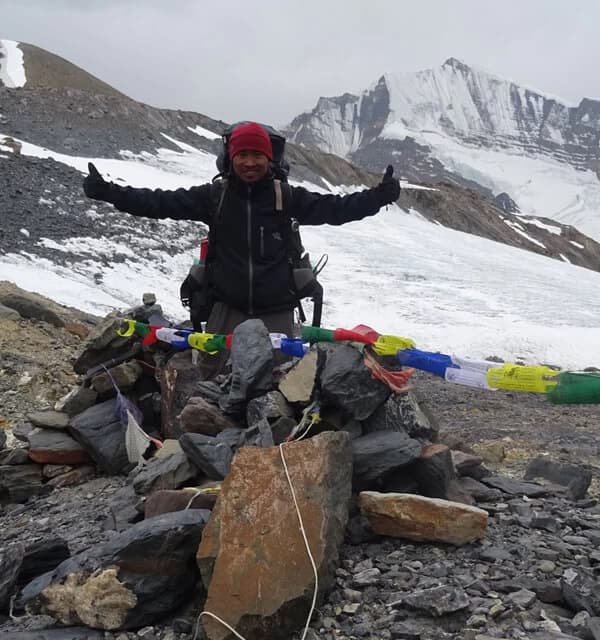Go off of the main traditional route of the Apple Pie Trail of Annapurna to a rugged, rough route and less explored Shangri-La of Nar Phu Valley to the north.
Nar Phu Valley Trek with Annapurna Circuit - 15 Days
Trip Overview
Nar Phu Valley Trek with Annapurna Circuit is a fantastic trip to the wild and lost valley of Nar Phu, offering an off-the-beaten-track wilderness experience in the Annapurna region. Nar and Phu villages are situated off the main trekking trail en route to Manang is surrounded by Pisang Peak to the south, Kangla Pass (5,320m height) to the west, Kangru Himal east, and Damodar Himal to the north. The villages are situated at an altitude of 4110 meters. Being nestled inside the valley, it is less windy, but the land is dry and rugged. Perhaps the late Prof. David Snellgrove, a renowned Tibetologist, is the first Westerner to have visited these villages in his Himalayan Pilgrimage. Their spoken dialect is different from Manang and Tibetan. Most of the houses are two-story with the entrance from the top. There are three Buddhist monasteries. Phu is located at the upper end of the valley. As in the high mountain area, the people of the Nar Phu descend to a warm region from December to February. The people of Nar have a closer relationship with Manang. Unlike people from Manang, they do not trade widely but rather concentrate on nearby areas in the south. The Gurungs of Lamjung used the lamas of Nar Phu as they believed they were experts; therefore, they had great influence.
Nar and Phu villages were lost around 1960 at the advent of Khampas (Tibetan warriors) until 1975. Khampas made their actual presence in 1964 and lasted until they were driven out of Nepal entirely. They waged insurgency operations in Tibet after the Dalai Lama escaped to India. The valley was opened to foreigners with a special permit in 2003. Since then, the lost village has been opened to the outside world. The Khampas were more powerful than the locals, so they dominated the villages. The valley was a secure place for them. Though it is near Lamjung in the south, for central administration, it is beyond their outlook post. In many aspects, Manang dominated every aspect of Nar Phu, though at a later stage, Lamjung exerted its influence as the people of Nar Phu detested the superiority exhibited by Manang. That is also one reason for the isolation that isolated them from the rest and deprived them of the development benefits happening around them. They have not been able to get out of the social clutch and the valley that surrounds them.
Occasional visitors to Nar and Phu villages were climbers. They go to climb Himlung Himal (7126m) to the east, on the border with Tibet of Phu and Kanguru (6981m) east of Nar. The French expedition to Kanguru in 2005 met a big climbing disaster due to an avalanche that happened near Meta. In 2009, another climbing disaster happened at Himlung due to an unexpected avalanche. Technically, both peaks are challenging than most trekking peaks. Nar Phu Valley is also approached from North north-northwest from Mustang through the high pass at Teri La Pass (5595m), Trek and Saribung La. These are not regular trekking routes but are used by the people of Nar and Phu and some wilderness trekking lovers. However, climbers liked to cross this pass after climbing Saribung Peak (6327m). Most trekkers visiting Nar Phu like to cross Kang la (5306m) to reach Manang via Ngawal and Braga on the other side of the valley. Other interesting places to combine with the Nar Phu Trek with Tilicho Lake (4920m) and Mesokanto La Pass (5121 meter high), and climb trekking peaks like Chulu West, Chulu East, and Chulu Central. Pisang Peak (6091), a training peak of the Nepal Mountaineering Association, is also very popular. Our original version itinerary of the Nar Phu Valley Trek goes through the famous Thorong La Pass in the Annapurna Circuit and ends the trek at Jomsom.
Kind of Accommodation and Cost in Nar Phu Valley and Thorong La Pass Trekking
Now, Nar Phu Valley is possible as a teahouse trek and a homestay trekking, and does not need trekkers to camp. One gets to indulge in the local culture, traditional houses, and the lives of the warm people who make the treks more enjoyable. Accommodation is not an issue in Nar Phu Valley. The trails are usually unfilled or less crowded, and new and improved tea houses are opening up all the time. No earthquake damage at all. The cost of a room on a twin-sharing basis usually ranges from NPR 500 – 800 (USD 5 – 10). The price goes higher as you walk higher. Please do not expect luxury, but something comfortable enough for remote and cultural discovery.
Guide and Porter Cost for Annapurna Circuit and Nar Phu Valley Trekking
Whereas many of the famous treks in Nepal do not have strict requirements for hiring licensed guides, all the controlled and restricted trekking areas in Nepal require mandatory and foreign trekkers be accompanied by a registered guide as per state law. The cost of a guide is USD 30 – 40 a day, depending on the quality, level of education, the experience of the guide, and the season. Porter's hire costs USD 20 a day. The cost covers wages, accommodation, and food for the guide and porter. Some companies also offer fresh guides, and they can act as Guide cum Porter (PcG) who carries some 10-13kg for you and simply guides you. Hiring a guide cum porter will cost USD 25 per day.
We recommend you take an experienced licensed guide as Nar Phu is an adventurous and high-altitude area; if something goes wrong, you need a good guide with all the technical knowledge for safety who can handle the crisis. The training and experience of a licensed professional guide can make your trek more fun.
Transportation Cost Nar Phu Valley Trek in Annapurna
As Nar Phu Valley is located north of the famous Annapurna Circuit and Throng La, the road access made it easier, and local buses to Besisahar from Kathmandu and connecting local jeeps to Syange/Jagat/Taal/ Dharapani or even to Koto and further up to Manang are available. However, only Kathmandu to Besisahar has a proper, smooth road, and it is a dirt and unsealed bumpy road between Besisahar to Koto-Manang, and the monsoon rain may affect the road if you are traveling in the rainy season. You have a choice to take a Local bus/jeep or rent a luxury 4WD private jeep from Kathmandu. A local bus will cost around USD 5 – 6 per person to Besisahar and USD 20 -25 per person to Koto, and a private jeep to Koto from Kathmandu will cost USD 250 - 350. If you are traveling in a group, the cost can be shared by all and would be cheaper. And the same for vice versa.
If you are combining this trek with Throng La or Mesokanto La Pass via Tilicho Lake and ending the trip at Jomsom, there are flights/buses available from Jomsom to Pokhara. Even a direct night bus to Kathmandu is available from Jomsom, which is much cheaper and can be arranged on the spot.
Jomsom - Pokhara flight costs USD 160 per person
Jomsom - Pokhara local bus fare is NPR 1700 - 1900 per person.
Pokhara - Kathmandu flight USD 100 - 105.00 per person.
Pokhara - Kathmandu by tourist bus USD 13 - 25 per person ( a private car/jeep can be arranged if you ask)
How much does it cost for meals in Nar Phu Valley?
As we mentioned earlier, Nar Phu Valley is a remote and rural area all the goods are carried by mules, horses, and human muscles, which makes it expensive. As the elevation increases, the price of food increases, and the menu choices decrease as it gets harder to transport more goods to remote places. The cost of each meal is approximately NPR 400 - 700, but it might vary according to your choice of food, the number of meals, and your appetite. Approximately USD 20 - 25 should be enough for a day of simple meals and tea/coffee. You will enjoy every bite, every sip after a hard day’s trek, and the hard work of the men and mules required to carry them to such elevations. Every single piece of food feels worth every penny for the relief and joy.
Drinks Cost
Bottle of beer: NPR 500 – 700 (USD 4.5 – 7)
Bottle of water/soda: NPR 50 – 400 (USD 0.5 – USD 4)
Nar Phu Trek Permit
As Nar Phu is a protected area, the government requires different permits to support to preservation of the area, limit the number of tourists, and control the borders with Tibet. These permits are required exclusively for the Annapurna Conservation Area. For September to November, the rate per person is USD 100 for one week Nar Phu Valley Trek Permit, and if you are visiting between December to August, the cost is USD 75 for one week per person. Beyond one week, it costs USD 15 / 10 per day per person. In addition, you need an ACAP (Annapurna Conservation Area permit). The cost is NPR 3000 (USD 30). And if you are combining this trek with the Annapurna Circuit, you will need a TIMS Card that costs NPR 2000.
Cost for other extra expenses
As the altitude increases, everything becomes more expensive due to the effort and cost of transporting goods there. It is the same for all high-elevation treks to the mountains in Nepal. Here is a list of things you might want to indulge in during the trek and their prices.
Charging Devices in trekking to Nar Phu Valley in Annapurna
You will need to charge your electronic devices, like cameras, phones, iPods, and others, as you spend days in the mountains. The cost is usually a few dollars, but in the long run, it will cost you more to charge for many things. The cost is higher to support the local hydropower stations, and there is no electricity everywhere but solar power. If you want to avoid this cost, you might want to carry a solar-powered battery charger or a portable power bank of your own. This ensures that you get to enjoy beautiful scenery and fun experiences, and share them with the world all the time. And you should know the battery and how long it lasts after charging till the next.
Hot Shower
Each day of the trek is an exhausting experience, and you may want to take a hot shower and get refreshed all the time. However, in the higher places, showers or baths are not possible due to the cold and the cost. While some lodges might have proper bathrooms, others provide only pails of water for your bath. These will cost you a few dollars every time, but they will not feel like a proper bath. Instead, it is a good idea to carry wet wipes and a small towel to freshen up in the morning as well as before bed.
Tipping and donations
If you like the services of the places you visit or the people you meet on the trails, you might want to tip them, and tipping culture is quite common in Nepal. It is usually a good idea to tip your guides and porters for their hard work if they make your trip fun, safe, and enjoyable. Various places in the high altitudes, like monasteries, stupas, and schools, will expect some form of donation from the tourists for the improvement of their infrastructure. You might want to keep aside a few dollars if you feel like contributing to such good causes. Trekking to the mountains of Nepal is one of the most adventurous trips you could ever enjoy. As you take in the majestic beauty of the mountains and green landscape, the warm welcome of the friendly people, and the thrills of the trails, you will get an experience worth every penny you spend. However, it is a good idea to avoid being overcharged for things that you get at reasonable prices.
How much does it cost for the inclusive package of Nar Phu Valley?
The amount you pay for the same trek depends on the travel agency you choose. If you pick an international agency, they may charge you around USD 1900 – 2200 per person, while as we are a local trekking company, our customized cost is 1199 per person on a twin-sharing basis with breakfasts. Some agencies charge for their brands' safety and convenience, and local companies provide equally satisfying services. It is your choice to pick the agency according to your budget and travel plans, though booking through a local agency is your direct contribution to supporting locals.
Nar Phu Valley Trek Itinerary and Variants:
Nar Phu Valley Trek will be 10 to 18 Days, according to the route you choose, and varies depending on the starting point as well. We suggest the moderate trekkers commence the trek at a lower altitude, which reduces the risk of getting altitude sickness.
This 15-day standard itinerary is combined with the Annapurna Circuit traverse of Thorong La Pass (5416 m), and we have four other variants of Nar Phu Trek:
1) Nar Phu Valley Mesokanto Pass via Tilicho Lake
2) Nar Phu Circuit Camping Trek Mesokanto La Pass - 18 Days
3) Nar Phu and Upper Mustang Trek traverse Terila Pass (5500m) - 22 Days
Nar Phu Valley Short Trek for those with time restrictions. See the 10-day itinerary below.
Day 01: Kathmandu to Jagat Drive (1300m): Time 8 to 9 hours
Day 02: Trek to Dharapani (1,960m): Time 7 to 8 hours walk.
Day 03: Trek to Koto (2,610m): Time 5 to 6 hours walk.
Day 04: Trek to Meta (3,560m): Time 7 to 8 hours walk.
Day 05: Trek to Phu Gaon (4,250m): 7 to 8 hours walk.
Day 06: Trek to Nar Phedi (3500m): Time 5 hours walk.
Day 07: Trek to Nar (4110m): Time 2 hours walk.
Day 08: Trek to Ngwal (3,660m) via Kang La Pass (5,320m): 7 to 8 hours
Day 09: Trek to Chame (2600m): Time: 7 hours walk.
Day 10: Drive to Besi Shahar – Kathmandu.
We begin our journey at early dawn as we have a long drive ahead of us. We head-start right after breakfast and leave Kathmandu around 7 am in the morning. We see picturesque views of Nepali countryside, lush greeneries, rivers, villages, farms and mountain vistas en route throughout the drive. After 8-10 hours of drive we reach Jagat via Besishahar. Drive up to Besishahar will most likely be smooth owing to black-topped roads whereas after Besishahar, the roads get dusty and coarse but the scenic view from our windowpane is more than compensating for the bumpy ride. Overnight in Jagat.
After breakfast, we leisurely start our trek today. The trail from Jagat descends until it reaches the river and then continues through a lush forest. Further ascent leads to sharp-edged cliff facing the riverbank. En route, Chyamje comes into picture amidst the glorious backdrop of towering Annapurna mountain ranges. After crossing a suspension bridge, we climb steeply towards the slippery and physically challenging path to Sattale. On treading along a succession of rock-strewn trails, we descend to a grassy riverbank that leads to Tal. As we walk away from Tal, the path becomes rugged and winding. Then we approach steep forested village of Karte. Meandering along the waterfalls and cliffs, we finally reach Dharapani after crossing a suspension bridge. Overnight in lodge at Dharapani.
We head to Bagarchhap which takes about one hour going through pine and fir forests. We can visit the white washed monastery in this village. Then we continue our trek till Danaque which takes about an hour. The trail is steeply ascending up to Timang. We have a good view of Mt. Manaslu and Peak 29 from here. Now the trail continues through pine forests again till Latamarang which takes about one and half hour. We break for lunch here and again resume through forests whereby we have a short glimpse of Annapurna II. Finally we arrive in Koto village. Overnight in lodge at Koto.
In the morning, we register our restricted area permit at the Police Check Post. Then we trek through the River bank of Soti Khola again through wonderful pine forests, streams and suspension and reach Dharamsala. We have our packed lunch on the way. We then continue the trek through forests and ascend steeply towards Meta village. Finally we arrive on the Tibetan Plateau where we have a very good view of Annapurna II and Lamjung Himal. Overnight in Meta.
Today, it is planned as acclimatization day whereby we are recommended to rest and get acclimatized with the altitude. As we are in the Lost/Hidden Valley, we can explore the culture, natural diversity, and religious practices of the local people. Besides this, we can trace out how people make their survival depending on agriculture, animal breeding and seasonal migrations in such remote location or in the hidden valley. It is also the day for us to explore the Tashi Lakhang Monastery – the old Buddhist Monastery listed out of the 108 world’s great Buddhist Monasteries; it is supposed to be the last monastery constructed by Karmapa Rinpoche. Apart from exploring the cultural avenues of the lost valley, the valley also offers us a great view of Himlung Himal and other snow peaks in the region. Overnight in lodge or homestay at Phu Gaon.
The trail descends passing many streams and suspension bridges until Mahendra Pul which takes about 5 hours. We pass the high suspension bridge 80m over the Gorge of Lapche River. We have lunch in Mahendra Pul. Many people continue to Nar which 2 hours from Mahendra Pul. We stay at monastic school at Nar Phedi. There is no lodge no village at this place.
It is a very short day today, the trail steeply ascends passing many Buddhist stupas until Nar Village which takes about 2 hours. We find several Buddhist Monasteries here to visit coupled with the glorious vistas of Pisang Peak and other small peaks. Overnight in lodge at Nar.
Today is daring day with long day hike of 7-8 hours so we get up early in the morning and head to Ngawal via Kangla Pass (5320m). From the pass we can enjoy the view of Annapurna massif. We further trek down to Ngwal from there. Overnight in lodge at Ngawal.
The weather gets warmer and the greener landscape as you go down more than 2000m from the pass. Set off early for the last few hours of trekking to reach Manang where most of the trekkers hiking to Annapurna circuit halt for acclimatisation. The trail is wide and pleasing. Stop for a quick snack in the village then walk to Manang
It is plan for an extra day if you need to rest your body or you can post some photos and stay update with your loved ones as there is internet (Wi Fi) services. You have choice to hike Ice Lake that offers stunning view of giant Annapurnas.
Today you walk to Leddar at the altitude of 4230 meter that is some 700 meter elevation gain. As we expect you are already acclimatized from Nar Phu and kang La pass you don't altitude proble,. overnight in Leddar.
It is short walk of some 4 hours to Phedi from Leddar, alternatively you can trek to high camp that makes you have short climb next day to Thorong la pass (5416m). However you need to consult with your guide whether you stop at Phedi or High camp for the night. Also most importantly you need to see how well you can go.
Trek to Muktinath via dramatic Thorong la Pass that is 5416 meter high from the sea level. Capture some memories at the pass then head down to Muktinath. Now you can celebrate your trek as you make it successful of the trek.
After breakfast, drive to Jomsom and take a scenic mountain flight to Pokhara. Upon landing at Pokhara, transfer to the hotel and check in. You can go exploring around Lakeside. stroll around the local market and enjoy an evening walk around Phewa Lake.
After an early breakfast. An escort to the tourist bus station by your guide and take a tourist bus to Kathmandu, a scenic drive through Prithvi Highway and the bank of Trishuli River that will take approximately 7 hours. Transfer to your selected hotel in Kathmandu.
This is our standard itinerary. It can be customized or slightly changed if required considering your pace and trekking habit that cause a change of day-to-day plan.
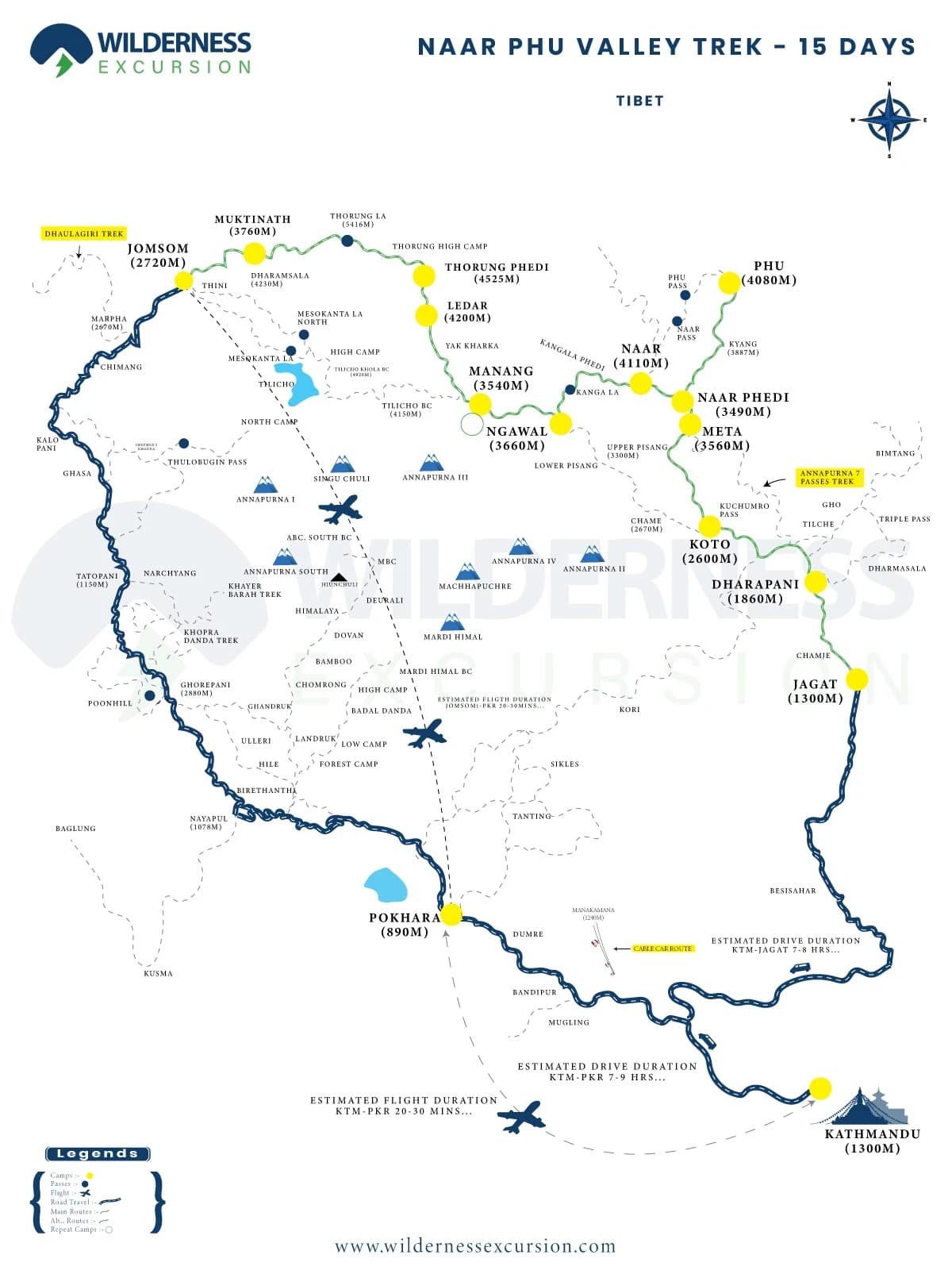
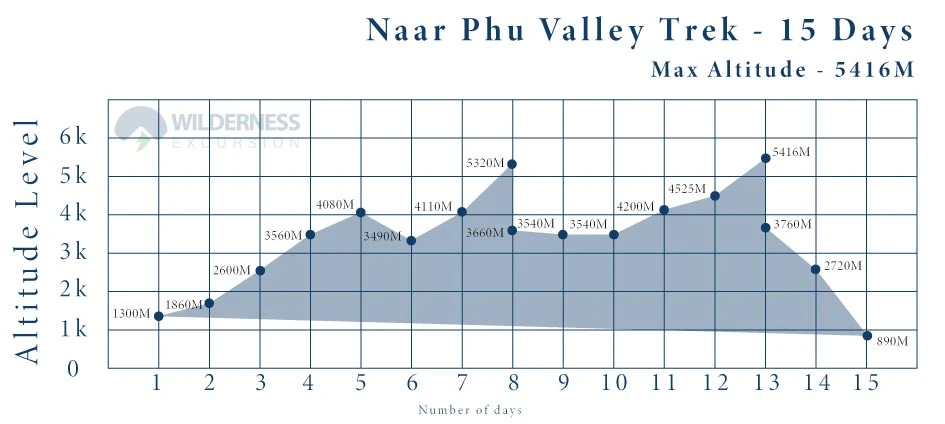
- Jomsom - Pokhara by flight with airport taxes.
- One night deluxe room in one of the best tourist standard hotels in Pokhara with buffet breakfast.
- A certified local Nar Phu Valley Trekking guide.
- 1 Sharing trekking porter for two trekkers (weight limit 25/kg / porter)
- Local sharing transportation to and from trekking.
- Trekking lodge and home stay accommodation on twin sharing basis.
- Meals: Breakfasts, Lunches and Dinners during the trek.
- Guide and porters fee with all their expenses in trek.
- All necessary Nar Phu Valley trekking Permits.
- Office service charge, government tax and vat etc.
- Insurance and trekking gear for guide and porters.
- Accommodation, meals and transfers in Kathmandu.
- Guided tour and monuments entrance fees in cities.
- Bar drinks, beverages such as coke, fanta, mineral water, laundry service, toiletries.
- Personal nature expenses, hot shower, hot water, internet and phone calls.
- Personal travel insurance and trekking gear.
- Hiring horse/pony or extra porter if necessary.
- Rescue operation charge in case of emergency.
- Gratitude and tips for your guide and porter.
Check our published date for Nar Phu Valley Trek Departure! If it doesn’t match, we are happy to customize your tour perfectly to suit your interests and needs. Contact us to create a unique travel experience for you!
Nar Phu Valley Trek can be personalized as per your requirements that meet your time frame, financial status, and places of interest to include in the itinerary. The trip cost we have offered here is on a minimum group size of two travelers basis. No single supplement cost is required. The cost will be according to Deluxe, Standard, Budget, and as per group size. This trek can also be combined with Tilicho Lake, Mesokanto Pass (5200 m), Teri La Pass, and Saring Pass Trek, extreme high pass treks linking to the Upper Mustang. Nar Phu Valley Trek requires a restricted area permit, which costs US$ 90 per week per person, and December-August US$ 75 per week per person or equivalent convertible foreign currency. In addition, an ACAP permit is mandatory and costs NPR. 2000.00 per person. You must trek with a licensed trekking guide and arrange with a government-registered trekking agency. Please kindly send us your details for the tailor-made program. See you in Nepal!
Nar Phu Valley; the know is hidden valley lies in the remote Manang district of Nepal, within the Annapurna region, just off the main Annapurna Circuit trekking route. This region is close to the border with Tibet, has a rich Himalayan culture, is a restricted area, which has helped preserve its original wilderness, ancient villages, and traditional lifestyle.
Typically, Nar Phu Valley Trek needs 12 to 14 days and requires additional 3 to 4 days if you would like to add some beautiful side trips such as Tilicho Lake, Thorong La Pass, explore around Maang Valley etc. And choosing the trek starting point also determines length or itinerary of Nar Phu Valley Trekking in Annapurna.
Renowned for its difficulty, the Nar Phu Valley Trek is a challenging adventure that culminates in crossing the formidable Kang La Pass at 5,322 meters (17,460 ft). Due to the extreme altitude and rugged terrain, this trek is recommended only for experienced and physically fit hikers.
- Difficulty Level: Challenging
- Key Feature: Crosses the Kang La Pass (5,322 m / 17,460 ft)
- Physical Requirement: Excellent fitness and prior high-altitude trekking experience are essential.
As per state law, Nar Phu Valley falls in a controlled area bordering Tibet. Like in other restricted areas, the Nar Phu Valley Trek requires a licensed guide. So all the foreigners trekking in the region must be accompanied by a registered guide and arrange your trek through a certified Nepalese Trekking Agency.
Wilderness Excursion provides one shared porter between two trekkers, and a porter carries a maximum of 20 to 25 kilograms, so approximately 12 kg of free luggage for each trekker. He will also be carrying some 5 to 7 kg of his own small pack, so the total he carries 30Kg max. A porter cannot just be your porter, but sometimes he can be your friend or companion to uplift your adventure spirit, to learn, and share.
The maximum elevation you reach in the Nar Phu Valley Trek is Kangla Pass at a height of 5320 meters above sea level. Himlung Base Camp is located at an altitude of 4,850 meters, making it a suitable destination for hiking. This is a good preparation for the Kangla Pass, which leads toward the Manang Valley.
Considering the environmental pollution issue, bottled water is banned in most areas of the Annapurna Trekking region and Nar Phu Valley, subject to the same regulation. You can have boiled water (it is paying) from the teahouses. The best alternative is carrying water treatment equipment or a purifier. Carrying a water purifying tablet (you can buy from pharmacies in Kathmandu) is much easier and handy.
To charge your gadgets in Nar Phu Valley Trekking, there is electricity in some areas powered by a mini hydro-electric station and solar power, where electricity is not supplied. Wilderness Excursion suggests you to fully charge your devices where electricity is available. Charging in solar power will cost (NPR 100 to 200 for a full charge).
The mobile network and internet service is limited in Nar Phu Valley. Purchase the NTC (Nepal Telecom) SIM card in Kathmandu or at the airport for data and calls, providing a copy of your passport and photo to register. Network coverage is best in lower altitudes and larger villages like Manang and Muktinath, but it becomes unreliable in Nar Phu. The network comes and goes. While teahouses offer Wi-Fi, it's often costly and very slow, making a personal SIM a better option for communication.
There are no banks or ATMs on the route to Nar Phu Valley and Annapurna Circuit. Credit Card Payment service is very limited or almost none, so please carry extra cash for your personal expenses, like having beverages (Coke, Sprite, juice) or if you donate in monasteries, taking a hot shower, etc. USD 10 to 15 per day, equal to NPR, should be sufficient. Though it depends on you how much you spend.
We did Nar Phu trip in July though it is not a really good time to trek but we have off time in July. We found it awesome! The trip takes you from jungle to alpine zone that are all...
We had such an amazing experience on the Nar Phu Valley trek. Could not fault Wilderness Excursion Company or our guide and porter! Every single person involved in our trip was incredibly caring, helpful, welcoming, and accommodating. A truly memorable...
We as a couple did this wonderful camping trek in April/May 2016. Everything was perfectly prepared. Pradip and his crew (guide, cook, porters) were awesome. They did everything to make it comfortable. They always had a plan b if there...
